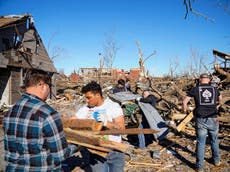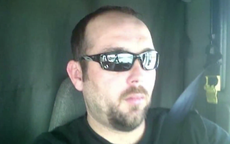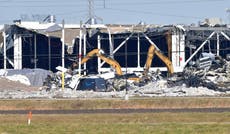The Independent's journalism is supported by our readers. When you purchase through links on our site, we may earn commission.
Kentucky is my warm-hearted home. We didn’t ‘reap what we sowed’ with the tornado
Some people in the national media have been derisive towards my home state, blaming its people for voting for senators who oppose climate change or disaster relief for other people. That is grossly cynical

Your support helps us to tell the story
From reproductive rights to climate change to Big Tech, The Independent is on the ground when the story is developing. Whether it's investigating the financials of Elon Musk's pro-Trump PAC or producing our latest documentary, 'The A Word', which shines a light on the American women fighting for reproductive rights, we know how important it is to parse out the facts from the messaging.
At such a critical moment in US history, we need reporters on the ground. Your donation allows us to keep sending journalists to speak to both sides of the story.
The Independent is trusted by Americans across the entire political spectrum. And unlike many other quality news outlets, we choose not to lock Americans out of our reporting and analysis with paywalls. We believe quality journalism should be available to everyone, paid for by those who can afford it.
Your support makes all the difference.I never thought I would be so happy to see a donut shop post on Facebook.
“Hello everyone,” wrote the Great American Donuts. “We’re ok on the Bypass.” Great American Donuts — or GADS, as it is affectionately known — was one of my regular haunts in college. I would spend hours there hanging out with friends, drinking coffee and gorging on apple fritters and Bavarian creams. It’s a staple of the student experience at Western Kentucky University and a local favorite in the Bowling Green community.
The Bypass they mention is the US Route 31-W, which winds its way around downtown Bowling Green. On Friday night, it suffered catastrophic damage in what is now being dubbed the Quad State Tornado, so-called because it traversed four states and 250 miles, leaving unprecedented levels of destruction in its path. As of this writing, at least 90 people are estimated to have died — 80 of them in Kentucky, and 11 in Bowling Green itself.
Heartbroken doesn’t even begin to describe what I am feeling. I moved to Bowling Green when I was 18, spending seven glorious years there, both as a student at WKU and as a “townie” who stayed because he loved the city so much. It is the first place I ever felt safe and accepted, where I found community and like-minded people, where I was able to be myself. To this day, Bowling Green is my adopted hometown, and many of the people who live there are as close to me as family.
I was last in Bowling Green in May. It was my first trip post-Covid, and that was no accident. I could not wait to see the gurgling baroque fountain that lends its name to Fountain Square in the heart of downtown; to walk along the old Civil War fort that now makes up the top of WKU’s campus, perched on the tallest hill in Warren County. (It’s why we’re called the Hilltoppers.) I ate my lunch at Reservoir Hill Park, a giant water tank painted like an American flag standing sentinel over the town.
Bowling Green has changed a lot since I left ten years ago. Businesses have come and gone, new buildings have sprung up left and right, and the population has grown by roughly 12,000.
In all the ways that matter, though, it is still the same place I always knew. It has all the amenities you could hope for — cinemas, museums, galleries, world-class dining and theatre and music venues (Cage the Elephant famously got their start at Tidball’s, a legendary local bar) — with all the warmth and charm of small-town USA.
I ran into people I hadn’t seen in years at the local Target. The baristas at Spencer’s, a coffeeshop on the Square, were as friendly and talkative as ever. Everywhere I turned I was greeted with smiling eyes (most people were still wearing masks) and warm welcomes. It was exactly as I remembered it, unchanged by time or the attention it received from the fictitious massacre that thrust it into the national spotlight early in the Trump administration.
Follow live updates on the Kentucky tornadoes
Yet looking at the photos posted on Facebook today, I struggled to recognize the town I’d been to only six months prior. So flattened were the buildings on the Bypass that it took the familiar stucco of Puerto Vallarta, a popular local Mexican restaurant, for me to figure out what I was looking at.
Neighborhoods are even worse. Houses I walked and drove by mere weeks ago — some that I recognized from their unique architecture on news photographs — were completely leveled. It’s cliché to say “it looks like a bomb went off,” but it’s the only analogy that I can think of to express the level of devastation. It’s like someone drove a lawnmower over half the city.
None of this compares to the grief my friends are experiencing. One spent much of Saturday looking for his dog, who went missing during the storm. They were reunited that night. Another is unsure where she will live now that her home and everything in it has been destroyed. She was optimistic, though, posting on social media that she was grateful she and her family were safe and for the neighbors who had reached out.
Other friends talked of neighbors they barely knew checking on them, bringing them coffee and other refreshments. Local churches stepped up to barbecue and provide food for the local community, as did several restaurants, which are feeding people free of charge. A fellow WKU alumni contacted me about setting up a fundraiser to help the community. I would like to target any funds at students and staff — food service workers, building service attendants, other low-wage workers — affected by the storm who may not have the economic resources to recover.
This community spirit does not surprise me in the least. It’s the Bowling Green I have always known. This is the community that fed me when I could not afford to feed myself; employees at a local gas station used to give me leftover food from the grill to eat when I had no money in my bank account, and another low-wage man once gave me the coat off his back because I did not have a winter jacket. It’s home. That’s the only word for it. Home.
Not everyone sees what I see. Some people in the national media have been derisive towards my home state, blaming its people for voting for senators who oppose climate change or disaster relief for other people. A few have insinuated that Kentuckians are reaping what they sowed. That is grossly cynical and so callous it borders on ghoulish. It is also not the Bowling Green I know, nor is it the Bowling Green I have seen these past few days.
I would invite those people to come on down to Kentucky once our people have rebuilt what we’ve lost — and we will rebuild, because that’s what Kentuckians do. We rebuilt our state after it was devastated in the Civil War. We rebuilt our state following the decimation of our mountains by Big Coal. We will rebuild again. And we will do it with the characteristic graciousness, charm, and hospitality that we are famed for.
These are dark days for my beloved Commonwealth. But I know that — in the words of our state song — one day soon the sun will once again shine bright on my Old Kentucky Home.



